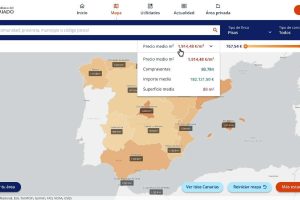GIPE Newsletter (Nº 24.184) October, 2nd 2025
TAXES:
THE SELLER DOES NOT RESIDE IN SPAIN
When the seller of a property in Spain is a non-resident prosecutor in Spain (as a general rule living outside of Spain for more than 183 days per year), the transaction has specific tax consequences:
Applicable tax: The profit is taxed under the Non-Resident Income Tax (IRNR), not the Personal Income Tax (IRPF).
3% Withholding (Form 211): The buyer must withhold 3% of the sale price and pay it to the Treasury within one month.
IRNR Settlement (Form 210): The profit on the sale of a property is calculated by subtracting the purchase price (less any expenses incurred such as commission or municipal capital gains tax) from the acquisition value (price paid plus initial expenses and taxes: notary, registry and agency fees, attorney fees, real estate agency fees, as well as the corresponding VAT or Property Transfer Tax).
The seller must declare the profit within three months of the buyer’s deadline for paying the withholding tax. In practice, this means a maximum of four months from the date of the Deed of Sale. A fixed rate of 19% is applied if the seller is from an EU country, Iceland, or Norway; and 24% if the seller is from another country. The 3% withheld is deducted and, if it exceeds the limit, is refunded.
Municipal Capital Gains Tax: This is the seller’s responsibility, but if the buyer is a non-resident, they must apply for this tax at the corresponding town hall within one month of signing the deed. In practice, an estimate of the Capital Gains Tax (which can be simulated on the town hall or property trust website) is usually withheld, and when the town hall issues the payment receipt (which can take a couple of months), the buyer pays it. If there is a surplus over and above the amount withheld, it will be returned to the seller. If there is a shortfall, the seller must pay the difference. IMPORTANT: The buyer should always request the most beneficial method for calculating the Capital Gains Tax. This must be indicated in their tax application.
In summary: for property sales to non-residents, the buyer must withhold and pay 3% of the price and, where applicable, the municipal capital gains tax to the Tax Agency. The seller then calculates the IRNR (Real Estate Tax).
HAS THE PROPERTY’S VALUE BEEN VERIFIED?
Value verification: If a property acquired before 2022 was subject to a value verification by the Tax Agency, the verified value becomes the acquisition value for the purposes of calculating the personal income tax gain. This can reduce the profit and, therefore, the tax payable.
From 2022: For Property Transfer and Property Transfer (ITP) taxes, the Cadastre reference value is applied (the higher of this and the price/deed), which avoids most subsequent verifications.
Until 2021: The taxable base was calculated based on the “real value,” which generated frequent verifications and additional assessments if the Treasury deemed the declared value insufficient.
Example: Using the verified value as the acquisition value allows you to declare less capital gain and pay less personal income tax on the sale.
Sale of a property. You purchased a home in 2012 for €100,000 and paid a Property Transfer Tax (ITP) of €7,000 (the Property Transfer tax rate in your autonomous community was 7%), as well as notary and registry fees of €2,000. However, in 2015, the property was subject to a valuation appraisal, which established a verified value of €150,000, requiring an additional property transfer tax payment of €3,500 (7% of the increase in value). However, if you did not appeal this assessment (thus making it final) and are now selling the property for €220,000 and incurring a municipal capital gains tax of €18,000, declaring the verified value will save you €12,095.
In turn, when purchasing a property for resale or second-hand today, it’s always a good idea to check the Cadastral reference value and verify that the price in the deed is higher than this. If it’s higher, the property transfer tax (ITP) must be paid based on that price. If the purchase price is lower than the reference value, it’s advisable to pay the property transfer tax (ITP) based on the Cadastral reference value; otherwise, the Tax Agency may issue a supplementary tax against the buyer for underpaying the corresponding property transfer tax.
In conclusion: verifying whether a prior administrative appraisal existed is key to reducing taxation when selling a property acquired before 2022. And check for property resales that the ITP is being settled based on at least the Cadastre reference value, or at a higher price in the Deed of Sale.
COMMUNITY OF OWNERS:
HOW DO I ASSIGN PARKING SPACES?
The use and allocation of parking spaces in common areas can generate conflicts between neighbors, especially when spaces are unequal or insufficient.
Common situation: In new buildings, this is usually provided for in the constitutive deed, but in older properties, the community must regulate it.
Rights: All co-owners may enjoy the common elements. The allocation must be proportional to the participation quota. If this is not possible, rotating shifts must be established. Claiming priority based on prior occupation of the space is invalid.
Agreements:
Some understand that it requires unanimity, but the courts usually accept a simple majority because it involves regulating use.
The agreement can be challenged if it does not respect proportionality.
Exception: If the area is already a private element of some co-owners, the rules of joint property apply.
Conclusion: It is best to allocate the common elements according to the participation quotas, and if this is not possible, through rotating shifts, always seeking consensus among neighbors.
Attention: Nowadays, some developers grant buyers exclusive use of a certain number of parking spaces and a storage room, but not the property itself. It is recommended that you carefully review the documentation with the Registry and the developer before signing the deed.
GIPE: Together we will stronger






